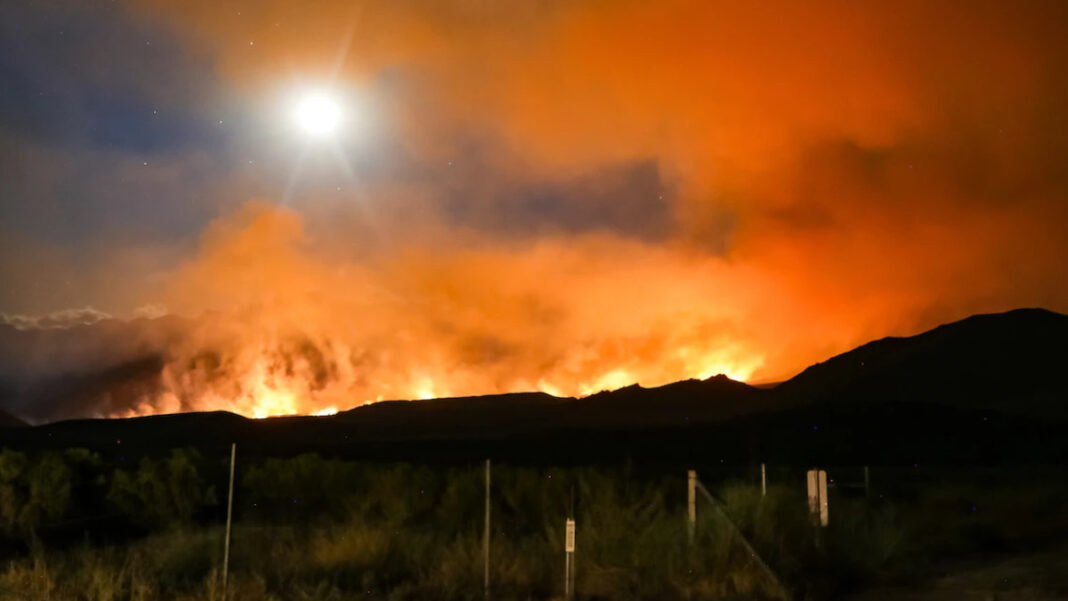SPAIN: Firefighter Manuel Rubio, who had been battling wildfires for more than a decade, said he had never witnessed a blaze like the one raging in eastern Spain for the past few weeks. Especially not so early in the year.
The forest fire, which broke out last Thursday close to the hamlet of Villanueva de Viver, had surprised Rubio and other fire experts by showing unusual ferocity for spring when in prior years, lower temperatures had helped keep fires manageable. That doesn’t augur well for a nation that led Europe in the burned territory during a record-breakingly hot 2022.
Hours before reentering the fray, Rubio, 39, told The Associated Press, “I was expecting a fire like the ones we usually see in March, which can consume 100 to 200 hectares, not the more than 4,300 hectares (11,600 acres) that this one has burned.”
“We are dealing with weather conditions appropriate for the summer and have a fire that is behaving like a summertime fire,” he added.
Due to climate change brought on by the release of greenhouse gases, the Mediterranean region is warming up more quickly than the global norm. Officials from Europe and Spain concur that the effects are already evident in the numerous heat waves and the protracted drought that Spain has experienced over the past few months.
These circumstances have turned Spain’s vast tracts of forests into a tinderbox that is just waiting for a random lightning strike, a spark from a tractor or saw, a carelessly thrown cigarette or an act of arson to ignite the scenery.
Climate change: Alarming condition leading to wildfire in Spain
According to government statistics, Spain saw a total of 267,000 hectares (666,000 acres) burned last year, making 2022 the worst year for fire destruction since 1994.
It was three times the country’s average of 94,000 hectares over the previous ten years. (232,000 acres). As per the Copernicus satellite observation service of the European Union, Spain accounted for 35% of all burned territory in European wildfires in 2022.
Pedro Sánchez, the prime minister of Spain, visited the scene of the nation’s first significant fire of the year and issued a dire warning that things would get worse unless some much-needed rain came to the rescue.
“Regrettably, catastrophic fires have become the norm in recent years. What is unusual is that we see them in March,” PM Pedro Sánchez stated on Monday. He added that “this has a lot to do with the climate emergency that the world is facing.”
Nearly 1,400 residents of Villanueva de Viver and other tiny communities in the hilly, rural region of Castellon province—which, like many interior regions of Spain, has an ageing and declining population—have been compelled to vacate their homes as a result of the fire.
Authorities deem that some 4,600 hectares of forest with significant ecological value have gone up in massive plumes of smoke. Twenty water-dumping aircraft and 500 firefighters are fighting to safeguard a neighbouring nature reserve.
Rubio and his fellow firemen face additional challenges because the region is full of small towns that are difficult to defend because they are encircled by trees. They have so far been saved from the fires.
Rubio stated that the vegetation in the area—primarily small, Mediterranean-style pine trees and dense brush—combined with unusually high temperatures and rainfall levels well below average created the perfect circumstances for the fire.
In this region of Castellon, where the average rainfall is over 100 millimetres (4 inches) during the winter, only 20 millimetres (0.8 inches) fell here.
On Wednesday, Ruben del Campo, a spokesman for Spain’s weather service, issued a warning that Castellon and the rest of eastern Spain should expect higher temperatures over the next few days, hitting 5–10 degrees Celsius (9–18 degrees Fahrenheit) above normal. He said that these are temperatures typically experienced in mid-to late-May.
According to Del Campo, the relative humidity decreases due to the rising temperatures and westerly winds that arrive in the hot and dry Mediterranean. As a result, the danger of wildfires increases significantly. Authorities are bracing for the worst in the extremely sensitive situation in Catalonia, Spain, which borders France to the north of the fire.
Sarai Sarroca, the director of Catalonia’s weather service, stated on Wednesday that their climate models had not anticipated such a huge rise in temperature until the year 2050.
Sarroca stated that one reason for the drought is the collapse of powerful, humid winds that typically sweep over the Pyrenees Mountains and contribute to the production of snow and rain in the winter.
Also Read: Adobe Unveils Firefly: The Next Evolution of AI-Driven Creativity and Productivity



